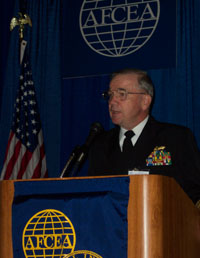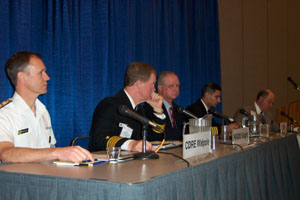Wednesday, February 2, 2005
Quote of the Day:
“Maritime situational awareness is an idea whose time has come.”
—U.S Pacific Fleet Commander Adm. Walter F. Doran, USN.
 |
| U.S Pacific Fleet Commander Adm. Walter F. Doran, USN, gives Wednesday’s breakfast address at West 2005. |
Leading off the day’s busy lineup was U.S Pacific Fleet Commander Adm. Walter F. Doran, USN, who focused on the topic “Beyond Iraq.” Adm. Doran related how the Pacific Fleet is supporting operations in Southwest Asia while also maintaining its existing commitments.
The fleet has changed its behavior pattern to increase its visibility in the Western Pacific Ocean, the admiral related. This new deployment pattern is accompanied by a focus on the most difficult theater warfighting categories.
One area where the Pacific Fleet has increased its emphasis is on antisubmarine warfare. The fleet has trained with new sensors such as an automated rapid periscope detection system and low frequency active sonar. An undersea warfare decision support system has great potential, the admiral offers, adding that the fleet can integrate its antisubmarine warfare assets better.
The fleet also participated in relief efforts following the post-Christmas tsunami. Adm. Doran stated that the size and speed of the fleet’s relief effort represents a persuasive display of U.S. Navy capability.
The admiral in charge of the largest area of responsibility for any one fleet discussed the need for maritime domain awareness. Saying that maritime situational awareness is “an idea whose time has come,” Adm. Doran stated that maritime interdiction is an area with great growth potential. The development and fielding of maritime domain awareness tools is essential, he declared.
The subject of networking the fleet came up in the day’s first panel. This group focused on how the Navy’s ForceNet will deliver its promises and how the Navy can keep U.S. allies plugged in.
Rear Adm. Kenneth Slaght, USN, commander, Space and Naval Warfare Systems Command (SPAWAR), related how the Navy’s IT-21 program took the first “baby steps” to ForceNet. However, IT-21 has problems such as bandwidth constraints and little redundancy. And, if one were to break down ForceNet, that person would find that every individual component is stovepiped. Adm. Slaght listed three key ForceNet issues: to be architecturally compliant; the ability to align with mission capabilities; and governance.
 |
Panelists discussing ForceNet are (l to r) Cmdre. Peter Walpole, RN; Rear Adm. Kenneth Slaght, USN; Col. James J. Kuzmick, USMCR (Ret.); Cdr. Gregory Glaros, USN; and panel moderator Capt. Dick Diamond, USN (Ret.). |
The British perspective on ForceNet was provided by Cmdre. Peter Walpole, RN, deputy, Striking Fleet Atlantic. Cmdre. Walpole noted that the U.S. Defense Department’s second priority—after the global war on terrorism—is to strengthen combined joint warfighting. He described it as good news that the U.S. Navy is the executive agent for the multinational information sharing initiative. Technologically speaking, good progress has been made. The commodore also cited the role of NATO in ensuring interoperability.
Cdr. Gregory Glaros, USN, of the Office of Force Transformation, declared that ForceNet is not just about technology—it’s about relationships. A key to its success will be to bring in all the autonomous and semi-autonomous agencies involved in ForceNet.
The Defense Department’s take on networking was presented by Wednesday’s luncheon speaker, Dr. Linton Wells II, acting assistant secretary of defense for networks and information integration and Defense Department chief information officer. Wells covered the terrain of network-centric warfare with descriptions of efforts underway and challenges ahead.
Wells listed five key network-centric programs: the Global Information Grid (GIG)-Bandwidth Expansion (BE); the Joint Tactical Radio System (JTRS); transformational communications satellites; network-centric enterprise services; and GIG information assurance. The GIG-BE program is on schedule to meet its next milestone by September; and transformational communications satellites will receive significantly higher funding in 2006. However, Wells said that he is disappointed in JTRS Cluster 1 and may restructure it. The other JTRS clusters are not a problem.
He elaborated that information assurance underpins all of these efforts. The National Security Agency has delivered six different plans that shy away from traditional digital “moats” in favor of strong identification authentication.
Wells said that he was encouraged by the 2006 budget process with information technology programs receiving strong support from Defense Department members. But, the single biggest issue that Wells raised is the department’s drive toward a data strategy.
This data strategy will enable smoother exchange of information throughout all aspects of the network by standardizing data. It would serve both authorized and unanticipated users such as coalition partners. Wells also predicted an increased emphasis on “sense-making.” The goal is to make sense of data for the user.
—Scheduled for Thursday at West 2005: Speeches by Adm. Timothy J. Keating, USN, commander, U.S. Northern Command; and Christopher Michael, founder and president of Military.com; along with panel discussions on joint interagency cooperation and sea basing.




Comments